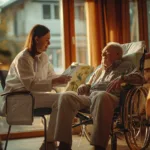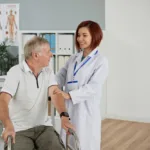
Geriatric Care Vs. Elderly Care
July 1, 2024
7 Key Roles Geriatricians Play in Enhancing Senior Lives
August 26, 2024Non-communicable diseases in geriatric care are crucial for managing chronic conditions and promoting overall quality of life. NCDs, such as cardiovascular diseases, neurodegenerative disorders, cancer, chronic respiratory diseases, and diabetes, are prevalent among the elderly population and can seriously impact their daily living activities.
The Importance of Geriatric Care in Non-Communicable Diseases
Comprehensive Assessment
Geriatric care professionals conduct thorough assessments that consider not only the medical condition but also the functional abilities, cognitive status, and psychosocial factors that influence an individual’s overall well-being.
Personalized Care Plans
Based on these comprehensive assessments, individualized care plans are developed to address the typical needs and health challenges faced by each patient. These plans aim to optimize the management of NCDs while promoting one’s independence and improving quality of life.
Multidisciplinary Approach
Geriatric care involves a team of healthcare professionals, including physicians, nurses, physical therapists, etc. This multidisciplinary approach guarantees that all aspects of an individual’s health and well-being are addressed holistically.
Medication Management
As individuals age, they may develop multiple chronic conditions, leading to complex medication regimens. Geriatric care professionals are skilled in managing polypharmacy, monitoring for potential drug interactions, and ensuring medication adherence.
Caregiver Support
Caring for an elderly loved one with non-communicable diseases can be challenging. Elder care services provide education, resources, and support to caregivers.
Also read: geriatric care vs elderly care
Common Non-Communicable Diseases in the Elderly
Non-communicable diseases are chronic conditions that are not transmissible from one person to another. Some of the most common NCDs affecting the elderly population include:
- Cardiovascular Diseases: Conditions such as hypertension, coronary artery disease, and stroke are prevalent among senior adults and can greatly impact their daily living activities.
- Cancer: With increasing age, the chance of developing different types of cancer increases. Cancers of the breast in women, prostate in men, lung, and colon are among the most common in the elderly population.
- Chronic Respiratory Diseases: Conditions like chronic obstructive pulmonary disease (COPD) and asthma can make breathing difficult and limit physical activity, affecting daily living activities.
- Diabetes: Type 2 diabetes is a metabolic disorder that can lead to complications such as vision impairment, kidney disease, and nerve damage, all of which can impact daily functioning.
- Neurodegenerative Disorders: Diseases like Alzheimer’s and Parkinson’s can significantly affect cognitive abilities, motor skills, and independence in performing daily tasks.
Understanding Daily Living Activities in Geriatric Care
Daily living activities, also known as activities of daily living (ADLs), are routine tasks that individuals perform to maintain personal care and independence. The two main categories:
Basic Activities of Daily Living (BADLs)
These include essential self-care tasks such as bathing, dressing, grooming, toileting, transferring (moving from one surface to another, like from a mattress to a chair), and eating.
Instrumental Activities of Daily Living (IADLs)
These involve more complex tasks that enable individuals to live independently within their communities, such as managing finances, shopping, preparing meals, using transportation, managing medication, and performing household chores.
Assessing an individual’s ability to perform these daily living activities is a crucial aspect of geriatric care. Healthcare professionals evaluate the level of assistance required and develop strategies to promote independence and maintain quality of life.
Comparative Analysis of Daily Living Activities in Non-Communicable Diseases
Non-communicable diseases can significantly impact an individual’s ability to perform daily living activities. The extent of this impact varies depending on the specific condition, its severity, and the presence of any associated complications or comorbidities.
Impact of Non-Communicable Diseases on Daily Living Activities
- Cardiovascular Diseases: Conditions like heart failure or stroke can affect mobility, balance, and endurance, making tasks like bathing, dressing, and transferring challenging. Cognitive impairments resulting from stroke may also impact IADLs such as managing finances or medication.
- Cancer: According to the type and stage of cancer, as well as the treatment modalities employed, individuals may experience fatigue, pain, and functional limitations that can hinder their ability to perform ADLs. Certain cancers, like lung cancer, can also affect respiratory function, further limiting physical activity.
- Chronic Respiratory Diseases: Conditions like COPD can cause shortness of breath and decreased oxygen levels, making activities that require physical exertion, such as bathing or household chores, difficult. Severe cases may require assistance with even basic tasks like dressing or grooming.
- Diabetes: Complications of diabetes, such as neuropathy (nerve damage), vision impairment, and amputation, can significantly impact an individual’s ability to perform ADLs. Managing medication and monitoring blood sugar levels can also be challenging for those with cognitive or visual impairments.
- Neurodegenerative Disorders: Diseases like Alzheimer’s and Parkinson’s can profoundly affect an individual’s ability to perform both BADLs and IADLs. Cognitive impairments, motor skills deficits, and behavioural changes can make even basic self-care tasks challenging, often requiring significant assistance or supervision.
Most Affected Activities
While the impact of non-communicable diseases on daily living activities can vary, certain activities tend to be more commonly affected across various conditions:
Bathing and Dressing
Activities that require physical mobility, balance, and agility can become challenging for individuals with conditions like cardiovascular diseases, chronic respiratory diseases, or neurodegenerative disorders.
Household Chores and Meal Preparation
Tasks that involve physical exertion, such as cleaning, laundry, or cooking, can be difficult for individuals with conditions that cause fatigue, shortness of breath, or mobility limitations.
Medication Management
Remembering to take medications at the correct times and dosages can be a challenge for individuals with cognitive impairments or vision problems associated with certain NCDs.
Mobility and Transferring
Conditions that affect balance, strength, or coordination can make activities like walking, climbing stairs, or transferring from one surface to another challenging and potentially unsafe without assistance.
Role of Caregivers in Managing Daily Living Activities
Caregivers play a vital role in supporting individuals with non-communicable diseases in managing their daily living activities. Their responsibilities may include:
- Providing Assistance: Caregivers may need to assist with tasks such as bathing, dressing, grooming, toileting, and transferring, depending on the individual’s level of functional ability.
- Promoting Independence: While assisting when necessary, caregivers should also encourage and support individuals to maintain as much independence as possible in performing daily living activities.
- Environmental Modifications: Caregivers can help identify and implement environmental modifications, such as installing grab bars, ramps, or assistive devices.
- Medication Management: Caregivers can assist with medication reminders, organization, and administration.
- Monitoring and Reporting: Caregivers monitor the individual’s condition, identifying any changes or concerns, and communicating these observations to healthcare professionals.
Also read: 5 major benefits of elderly care services
Case Study
A cross-sectional study conducted at Dr D. Y. Patil Medical College, Pune, explored the impact of non-communicable diseases (NCDs) on the functional status of 102 elderly patients aged 60 and above, excluding those with a history of strokes or limb amputations.
Age distribution:
- 60-74 years: 73.5%
- 75-84 years: 22.5%
- 85+ years: 3.9%
Comorbidity Data:
- No comorbidities: 37.3%
- One comorbidity: 26.4%
- Two or more comorbidities: 36.3%
Barthel Index Scores:
- Mean score for participants without comorbidities: 87.11
- Mean score for participants with one comorbidity: 83.89
- Mean score for participants with two or more comorbidities: 82.30
Most Affected Activities:
- Stair climbing: 75.7%
- Bowel control: 48.5%
- Mobility: 47.1%
The findings highlight the significant impact of NCDs on the daily lives of the elderly, underscoring the need for targeted healthcare interventions and comprehensive care strategies to improve their quality of life.
Geriatric care plays a pivotal role in supporting individuals living with non-communicable diseases and managing the impact of these conditions on daily living activities. By providing comprehensive assessments, personalized care plans, and a multidisciplinary approach, geriatric care professionals aim to optimize functional abilities, and the elderly population’s overall quality of life is enhanced.
Also read: roadmap to finding geriatrician near me

